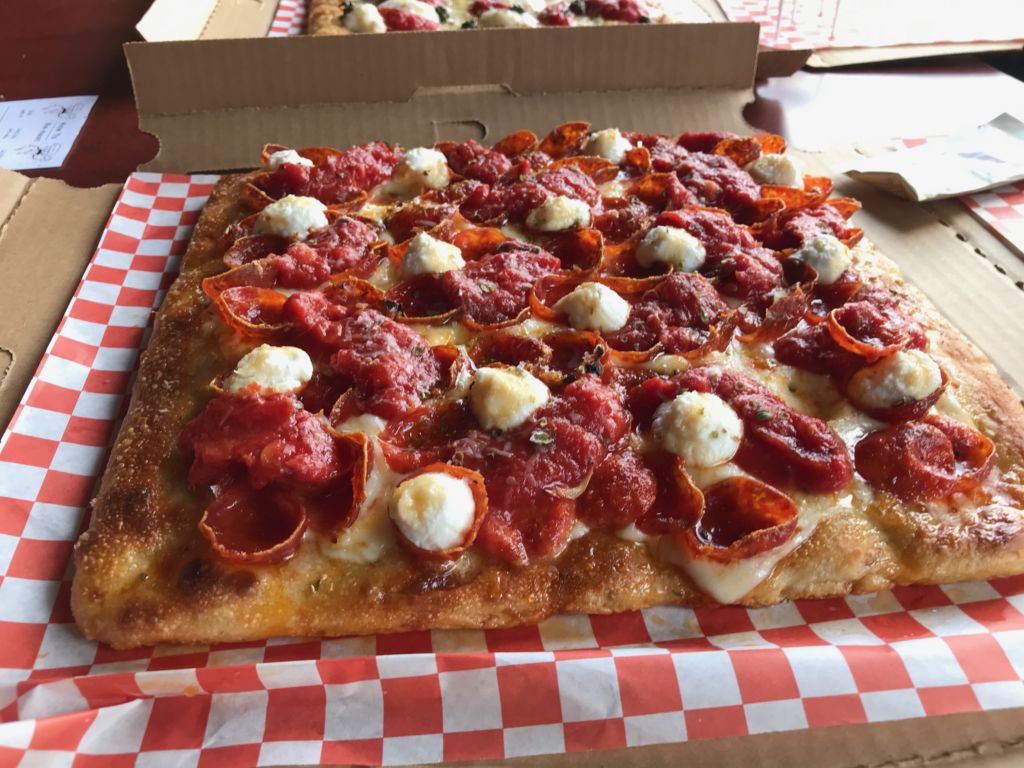
Chicago Embraces Square Pizzas, Part 2: Grandma & Roman
Grandma-style pizza from Professor Pizza
Chicago is in the midst of a square revolution. Not the tiny, palm-sized squares you see on your favorite neighborhood bar pie, but rather, the puffier, thicker slices inspired by Rome, Sicily and Detroit. After a century of circular pies, we seem to have been embracing pans with 90-degree angles as of late. I kicked off this mini-series yesterday, focusing primarily on Detroit, but today we’re moving into a pair of styles that have only recently begun to show up in Chicago. The first, Roman, appeared 20 years ago in Wicker Park, although no one paid much attention until its slicker, more established (and longer fermented) cousin showed up in the West Loop two years ago. The Grandma is a complete stumper to most Midwesterners, although I know my readers from New York will nod in agreement that it’s one of the best styles you’ve probably never seen here (and if your fancy friends from NYC who claim to know pizza don’t know what a Grandma is, then you’ve finally unmasked them for what they really are: pizza poseurs). I’ll finish the series tomorrow as we talk about the new wave of Sicilians available in the city.
(*indicates if pizzeria was, or currently is on the itinerary for one the Pizza City USA tours I oversee).
GRANDMA
Grandma-style is a square style of pizza more commonly seen in New York City than the Midwest. Widely acknowledged to have been created on Long Island at King Umberto’s in the 1980s, it’s usually made in a shallow, rectangular aluminum pan. But unlike the Sicilian, with its overnight (or two or three nights’) rest and time to rise in the pan, the Grandma is mixed and baked usually the same day, resulting in a shorter slice that’s a tad crispier. The tradition stems from Italian grandmothers who would make dough early in the morning, leave it out at room temperature to proof and rise, then top it and bake it in time for dinner. At places like Sofia Pizza Shoppe in Manhattan or Good Pie in Las Vegas, they’ll offer an “upside down,” which has cheese as a bottom layer, protecting the dough from getting soggy, topped with sauce (ironically, the same order of assembly as a deep-dish). This method results in the sauce getting slightly reduced from the baking process, concentrating its flavor and thickness. As far as I know, there have never really been any pizzerias in Chicago making East Coast legit Grandmas on a regular basis, until I heard about Anthony Scardino’s weekly pop-up.

Scardino, who goes by the moniker Professor Pizza, worked in the kitchens at Publican Quality Meats and Au Cheval before settling in for nearly two years as the General Manager at Dough Bros (400 N. State St.) in River North, where he came up with several different varieties, including large NYC-style pies with slices meant for re-heating. A pizza journeyman, he’s logged time in Tony Gemignani’s legendary pizza kitchen in San Francisco, then Coalfire here and *Paulie Gee’s Logan Square, where he was part of Tung’s opening team and helped him create his Logan Squares. He’s also spent time working with Rosso Pomodoro, the company overseeing the Neapolitan pizza training for *Eataly.
“When the pandemic hit, I started making focaccia, keeping it super simple,” said Scardino, who had been taking a break during the pandemic, only to find himself, after streaming a few seasons of “The Sopranos,” itching to bake again. He started off with a focaccia-style pizza. “I put up a Facebook post and the next week, sold 16 out of my apartment,” he said. The following week he sold 40. Then he switched to the Grandma style, selling about 80 pizzas a week.
Scardino says the owner of The Full Shilling (3724 N. Clark St.) – an Irish bar next to Metro – just a block north of Wrigley Field, had been remodeling the space. Scardino had helped him formulate the bar’s thin-and-crispy tavern-style pie, and the owner wanted him to come back to teach the staff a refresher course. Since the Grandmas were selling well from his apartment, he asked if it would be o.k. to start using the bar’s kitchen as a central pick-up spot for online orders.
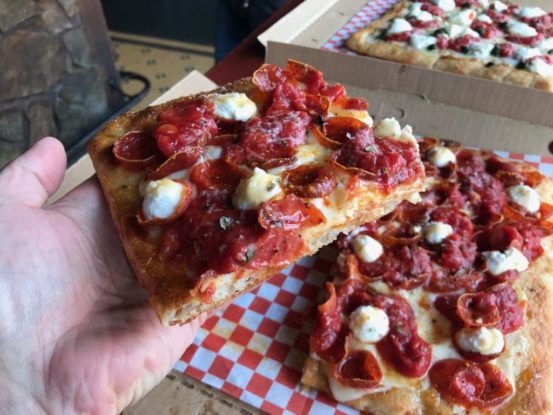
“It might be six months here, or it might be six weeks,” said Scardino. He’s now in the process of looking for a brick-and-mortar location.
His all-natural starter is used for an initial rest of two days, utilizing Caputo Americana flour. He’ll use just a fraction of active dry yeast, but a lot of hydration – about 70% of the volume is water. Bakers like higher hydration doughs because they create steam when baked, and combined with longer fermentation times – giving the yeast more time to eat the sugars in the dough and create carbon dioxide – the interior “crumb” of the dough opens up, resulting in small air pockets. This adds complexity to the chew; the opposite of pizza crust tasting like cardboard, and more like the experience of biting into a tender ciabatta or a firm baguette. He balls up the dough the same day he makes it, letting it rest at room temperature for an hour. Then it goes into a cooler for two days of fermentation. After that resting period, he lines a black steel pan with olive oil, pressing the dough out into the pan and letting it proof for about an hour-and-a-half. A quick four-minute par-bake sets the dough, which is then placed in cooling racks and held until he’s ready for baking.

Three flavors of the Grandma are available each week, plus one “Extra Credit” pie that will rotate (a recent one featured a spinach-artichoke inspired by NYC’s Artichoke Basille). His margherita features Wisconsin’s Grande (a brand used frequently in the industry) fior di latte, or fresh mozzarella, but also a 50-50 low moisture shred, Calabrian oregano, slivered garlic and a special blend of Stanislaus tomatoes. Dotted with a verdant green pistou – a sort of pesto without pine nuts – it’s remarkable not only for its appearance, but its crunch – a toothsome affair, requiring more jaw work than your standard Chicago thin. His pepperoni with fresh ricotta and Mike’s Hot Honey was hard to stop eating after just one slice (four giant slices can be cut from one pie). The undercarriage is riddled with tiny craters, like a view of the moon from 10 miles up, quite crispy on the whole, while the interior is definitely thinner than a standard Sicilian.
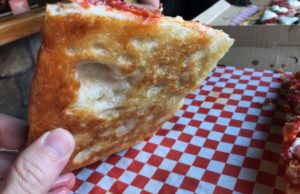

“I think it’s less a hurdle to explain a non-indigenous style of pizza as it is to explain slice culture [to Chicagoans] said Scardino of the inherent challenges in communicating something as foreign to Midwesterners as Roman al taglio or Grandma. “Here they want you to bag up utensils and put everything in a clamshell and it’s a whole production. In New York they finish half the slice by the time they pay for it.”
Scardino offers his Grandma-style pies for pickup every Friday and Saturday, 11 a.m. until 8 p.m. from The Full Shilling, but they’re limited, so you need to order ahead. Delivery is also available. Every Monday morning, the order form goes up on his Tock page.
Professor Pizza – Fridays & Saturdays only
At The Full Shilling Public House
3724 N. Clark St.
9” NYC slices for dine-in
Grandma pies for pickup or delivery
Dough Bros Pizzeria & Sub Shop
400 N. State St.
312-600-9078
(Grandmas not available every day; call ahead)
ROMAN
One of the guys Scardino referred to as he praised Chicago’s willingness to adopt new styles was Gabriele Bonci. The founder of Pizzarium, with several locations in Italy, has expanded on a style called Roman al Taglio (“by the cut”) that’s been around for about 50 years. With the help of people like Rick Tasman, a former P.F. Chang’s executive, and Chakib Touhami, the brand is now slowly expanding around the U.S. Under the LLC of Bonci USA, their first outpost was in the West Loop (161 N. Sangamon St.). A second location in Wicker Park recently closed, but they have plans to add stores in the suburbs and another in the city; a shop in New Orleans has opened while another is planned for Miami.
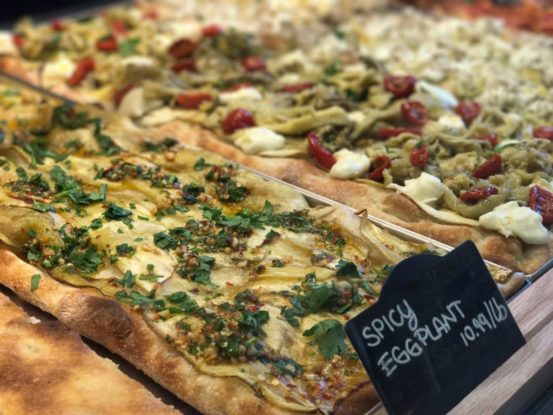
The “al taglio” refers to a process involving scissors. You tell the employee behind the counter how much of the pizza you’d like – using your fingers or other pantomime – then they’ll cut it from the rectangular pan and weigh it. You pay by the pound. The slices are topped with all manner of seasonal and regional specialties. Personal favorites include a thinly-shaved zucchini accented with freshly-ground black pepper and bright lemon zest, but you’d be just as struck by how good the potato-mozzarella is, or the octopus. They recently started making an Italian Beef flavor with the namesake, thinly shaved, plus housemade giardiniera.
The pizzas are stretched and baked in large steel rectangular pans, but after they’ve baked on the stone decks of the Castelli ovens imported from Italy and you’ve placed your order, the employee will reheat the slice in a different oven, then cut them into tiny, almost tapas-sized squares for easy eating. The focaccia-like interior is a result of three flours, a lot of water in the dough and a 36 to 72-hour fermentation. The second bake ensures a hallmark of all Roman pies: they must be crispy.

Almost 20 years before *Bonci opened its first store here, Marco Schiavoni opened *Pizza Metro (1707 W. Division St.) on a long-neglected block of Division St. in Ukrainian Village. Unlike al taglio, his slices were not cut to-order, and the flavor options stayed more basic, but always included a very Roman cheeseless marinara and a potato-rosemary. The restaurant gets its name from the Roman style “al metro” or “by the meter” since whole pies are typically about a meter long before cutting-up. The squares here remain fairly small – again, perfect for a snack or a light meal for one, and the crusts are adequately crispy.
Bar Cargo (605 N. Wells St.) in River North (part of the Stefani Restaurant Group) is making Roman pizza al metro, claiming they do a 96-hour rise and baking in the same Castelli stone ovens as Bonci uses, but the smallest size they offer is about the size of a child’s boogie board – made for two or more people – so dining solo is nearly impossible unless you want to take home lots of leftovers, and snob that I am, rarely eat cold or re-heated pizza, unless it’s a proper slice on a pre-heated pizza stone.
Even Greg Wade, the James Beard Award-winning Baker at the venerable Publican Quality Bread (808 W. Lake St.) is getting into the spirit. On Mondays, he has a Pizza Night, crafting a hand-tossed artisan pie as well as a puffy Roman version (each served cut). The open crumb in the Roman is off-the-charts when compared to the other options in town. Get ready to chew.
The theme at L’Aventino Forno Romano (355 E. Ohio St.), located in a tiny corner of a Streeterville high-rise, is mostly about a particular sub-category of Roman-style pizza called pinsa.
“When you eat pinsa, you look at the crumb structure, it’s really recognizable as a Roman thing – it’s got big air pockets, lots of fermentation going on, it’s light, airy and crispy,” said Adam Weisell, the Chef-Owner who spent time living in Rome. I did a story on the pinsas for ABC 7 about two weeks ago.
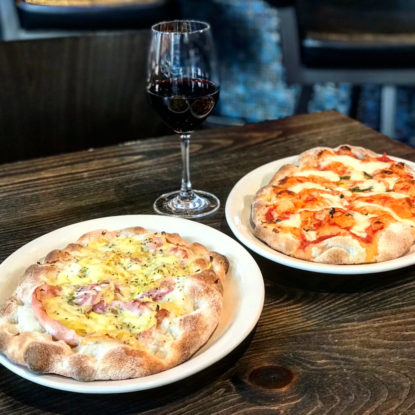
The dough has an all-natural starter, lots of moisture, and rests for at least two to three days. It’s pliable to the point of creating tiny craters when pressed with the tips of his fingers.
“This is a next generation one, and what I mean by that is it also incorporates some non-GMO soy flour, as well as some rice flour. This lowers the gluten content and just aids in the digestibility,” he said.
They drizzle on olive oil, then par-bake the crusts for a few minutes and hold them on a wire cooling rack, until orders come in. A basic margherita begins with fresh tomato sauce, some shards of basil and a generous handful of fior di latte, or fresh mozzarella. Just a little drizzle of oil and then into the oven for about three minutes, until the outside has formed a sturdy crust, while the interior portion of the heel has that nice, complex, open crumb structure. Pinsas are cut into squares just before serving
Other Roman variants include a tavern style, a lot like the Chicago version, cut into tiny squares (the only local version I’ve seen of this style is at Pizzeria Via Stato in River North). Danny Meyer tried creating a whole brand with this style, called Martina in New York City’s East Village, but closed it up about a year ago.
Tomorrow: I wrap things up with a round-up of some of the old school bakery slices plus the four new Sicilian-style pizzas in town that are real game-changers. If you want more pizza in your life, be sure to listen to/subscribe to the Pizza City podcast or sign up for one of our weekly Pizza City USA tours.
Bonci
161 N. Sangamon St.
312-243-4016
Pizza Metro
1707 W. Division St.
773-278-1753
Bar Cargo
605 N. Wells St.
312-929-0065
Publican Quality Bread – Pizza Night Mondays only
808 W. Lake St.
312-605-1618
L’Aventino Forno Romano
355 E. Ohio St.
312-964-5112
Pizzeria Via Stato
620 N. State St.
312-642-8450

Great piece, Steve. G- Ma and Sicilian were talked about quite a bit in August at this year’s Int’l Pizza Show in Las Vegas. Most cities are just now seeing these styles begin to be represented within the local pizza landscape. Keep up the good work!
Thanks Paul!
TRY SHEET PAN PIZZAS FROM THE GOODE AND FRESH PIZZA BAKERY IN GLENVIEW.THEY HAVE BEEN MAKING THEM SINCE 1983.THEY ARE DELICIOUS!
Will do. Thanks for the heads-up!